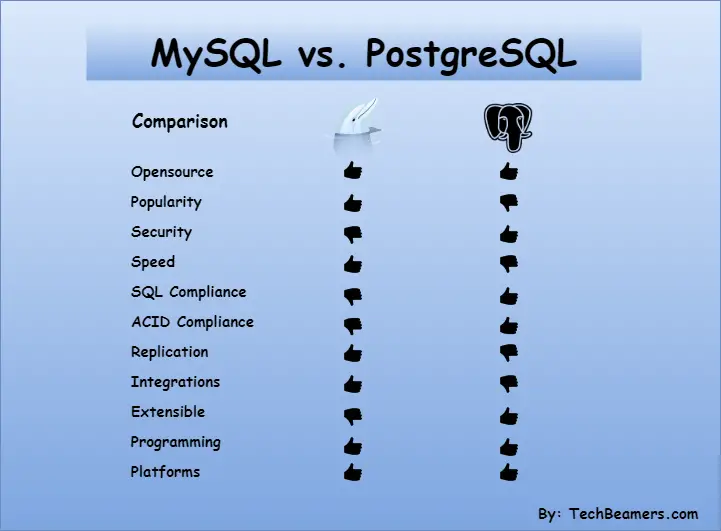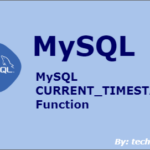This tutorial explains MySQL vs PostgreSQL, i.e., the difference between MySQL and PostgreSQL. It intends to help you understand the pros and cons of each of these RDBMSs. So, you can think in the right direction and choose a DBMS that fits most of your requirements.
The Difference Between MySQL and PostgreSQL
Here, you will find a point-by-point comparison between the two most used and popular RDBMS solutions. To start with, MySQL is used quite frequently because of its simple features and quick integration capabilities. On the other hand, PostgreSQL has the most advanced features that could help you scale a growing business.
Where PostgreSQL is famous for its focus on extensibility and technical standards compliance, MySQL is known for its developer interfaces and extensive documentation. PhpMyAdmin is a widely used tool for managing MySQL. Similarly, there is pgAdmin which can be used to administer PostgreSQL.
Must Read:
Compare MySQL and MongoDB
Compare Python SQL Libraries
MySQL vs PostgreSQL – Key Differences
Let’s now check out what are the pros and cons of both MySQL and PostgreSQL. When deciding between MySQL vs PostgreSQL for your database needs, it’s important to consider their differences.
Open Source
MySQL was created by Michael Widenius, Allan Larsson, and David Axmark in 1995 at MySQL AB. They used C and C++ languages to develop it. It is now an open-source software maintained by Oracle. It means you can use MySQL for free and can also modify its source code. MySQL operates under the GPLv2 license, so make sure you understand its guidelines. A commercial edition of MySQL is also available which comes with some addons.
It was Michael Stonebraker who created PostgreSQL in 1996 at the University of California, Berkeley. He used pure C programming language for development. It is also an open-source software under the PostgreSQL Global Development Group. It means you can use PostgreSQL without paying a penny. PostgreSQL uses a FOSS (Free and Open-source) license, which is also GPL-compatible.
After Oracle took over MySQL, the developer community lost control which slowed down the new feature addition. On the contrary, PostgreSQL has a thriving set of people who voluntarily contribute to its documentation, wiki, and discussion forums.
MySQL vs PostgreSQL: which one is better for your project? Let’s explore the key factors that can help you decide.
Popularity
MySQL is one of the world’s most widely used database systems. And, there are already a lot of people, majorly DBAs who have real-time experience in using MySQL. Moreover, it has plenty of documentation, both online and offline, to guide on installation and running of a MySQL database. Additionally, many third-party tools like phpMyAdmin and DBeaver are available to onboard any newbie quickly.
PostgreSQL, which got a launching in the same period, couldn’t become as popular as MySQL. Due to low penetration, it has fewer tools developed to run a PostgreSQL database. Also, the market didn’t produce enough jobs in this area. Hence, the no. of people who knew it is relatively less as compared to MySQL.
MySQL holds the top database software position in the year 2019 as well. As per the latest market survey, it tops the Database Popularity chart with 52%, followed by PostgreSQL at 36% of the total consumption.
Security
It represents the capability of a DBMS to protect the database from unauthorized access, threats, and attacks like SQL injection. A DBMS can make use of processes and tools to ensure the security of its environment.
MySQL provides a script that ensures the security of your database. It defines the password security level, sets the passphrase for the root user, cleans any anonymous accounts, and drops the test databases if there are any. Also, MySQL enables user management and can control the access privileges for every user.
PostgreSQL has a notion of ROLES and inherited roles to give and control permissions. The SSL support is built-in, and client/server communications happen over an encrypted channel. It builds security at the record level.
Moreover, there is another built-in module, SE-PostgreSQL. It implements extra access controls as per the SELinux security policy.
In the MySQL vs PostgreSQL debate, MySQL is often preferred for its speed and simplicity.
Speed and Performance
Many metrics and use cases factor in evaluating the performance. Also, it could vary if any of the parameters change, so it is carried out in a controlled environment.
MySQL is a default choice for web applications that use it merely for transactions and not anything tricky. It serves efficiently in Online Analytical Processing (OLAP) and Online Transaction Processing (OLTP) systems which expect a high read speed. However, the performance could degrade in heavy loads or running complex queries.
PostgreSQL works well for large systems where read and write speeds matter the most. It operates seamlessly even for executing complex queries. It delivers the desired read/write speed in both the OLTP & OLAP systems.
Some recent benchmark tests show that PostgreSQL gave a similar performance as MySQL. But, MySQL still claims to be an exceedingly fast database solution. Also, if your application requires faster read operations, then PostgreSQL may not be the right DBMS.
Try Reading: 25 SQL Performance Tuning Interview Questions
SQL compliance
Understanding the differences in SQL support and licensing is crucial when comparing MySQL vs PostgreSQL.
SQL compliance could be essential, but MySQL does not follow the full SQL standard. It has some functional limitations such as the lack of support for FULL JOIN. So, if your use case demands complete or near-complete SQL compliance, then you must seek a fully compliant DBMS solution.
On the contrary, PostgreSQL is fully compliant with SQL standards. As per the official documentation, PostgreSQL has 160 out of the 179 features covered for full core SQL:2011 compliance. Moreover, it also provides a long list of optional features.
ACID Compliance
ACID is an acronym for Atomicity, Consistency, Isolation, and Durability. It represents a set of properties relevant to database transactions. The ACID compliance guarantees that no data would get missed or corrupted in case of system failure, even if it was getting updated multiple times during a single transaction.
MySQL does not by default adhere to ACID. But it does when used along with InnoDB. PostgreSQL has native ACID support and doesn’t require any extensions for this compliance.
Replication
Replication is the ability to share information across two or more database servers. It ensures that all users have access to the same data. And it improves reliability, stability, and fault tolerance.
MySQL has a rich level of support for replication. It uses a master-master model which makes every node update each other’s data. It also supports on-way replication a.k.a. master-slave.
On the contrary, PostgreSQL support for replication is a bit complicated but robust. It works in the master-slave mode where the master node database holds all the information. However, the slaves DB provides read access. PostgreSQL does allow other types of replication via third-party solutions.
In short, we can say that MySQL is more mature in enabling Replication because its support is built-in and easy to implement.
Integrations
It is quite easy to gear up MySQL for an excellent performance. Also, it provides a rich set of APIs for integration with explanatory documentation. Moreover, it gels with almost every web server available on the planet.
MySQL is an integral part of the most famous, LAMP (Linux, Apache, MySQL, PHP) stack. It is an open source and the backbone of many great websites on the Internet.
- WordPress
- Flickr
- Wikipedia
- Tumblr
Similarly, PostgreSQL finds its place in Bitnami’s LAPP (Linux, Apache, PostgreSQL, PHP) stack. But it is not as popular as the LAMP. Many top websites are using Postgres as their backend solution.
- IMDb
- Etsy
Extensible
It reflects the ability of a database that the user can extend it by adding new data types, operators, functions, index techniques, and procedures.
MySQL has no built-in or external support for extensibility. But PostgreSQL includes many features to enable extensibility. It provides options to add new types, new procedures, new kinds of indexes, etc.
Hence, PostgreSQL stands out in terms of data integrity and extensibility when compared to MySQL. The MySQL vs PostgreSQL decision may hinge on whether you prioritize ease of use or advanced features.
Programming Languages
Programming language support is critical as it can attract a wide range of developers to use a particular database solution. They can even opt to access it using different languages on a case-by-case basis. Hence, if the server has rich programming I/F, then programmers are certainly going to like it.
MySQL comes with a set of programming interfaces such as C, C++, Java, Lua, Delphi, Perl, .NET, Node.js, Go, R, D, Python, PHP, Lisp, TCL, and Erlang. It allows interaction via ODBC which is available from both Windows and Linux.
PostgreSQL also supports several programming languages. You can use C, C++, .Net, R, Perl, Python, Java, JavaScript, Ruby, Tcl, and others. It can even run the client code in a separate process asynchronously.
Platforms
Not only a client application but the database server can also run on a variety of OS. The more no. of OS, the database supports, the more will be its consumers.
Both PostgreSQL and MySQL servers support Solaris, Windows OS, Linux, and Mac OS X. The OS X is an Apple product, Solaris is from Oracle, Windows comes from Microsoft and Linux is an open-source initiative. Additionally, PostgreSQL can run on HP-UX OS, which is developed by Hewlett-Packard. Likewise, MySQL is available for FreeBSD platforms.
It is also important to mention that both DBMSs can run on cloud platforms such as Azure and AWS.
MySQL vs PostgreSQL Facts
After reading a lot about the difference between MySQL vs PostgreSQL, check out this quick summary as well.
- MySQL is a pure RDBMS whereas PostgreSQL is an object-relational DBMS.
- Both these support Solaris, Windows OS, Linux, and OS X. Additionally, MySQL runs on FreeBSD and PostgreSQL on HPUX.
- MySQL is from Oracle while PostgreSQL PostgreSQL runs by a group of many companies a.k.a. PGDG.
- My SQL is not extensible, whereas PostgreSQL has it.
- PhpMyAdmin enables GUI and SQL interface for MySQL. Whereas, the pgAdmin tool does the same for PostgreSQL.
- MySQL has built-in tools for offline database backup, whereas PostgresSQL takes full backup online.
- PostgreSQL has built-in SSL support, but it doesn’t come in MySQL by default.
Which should you choose?
In conclusion, the choice between MySQL and PostgreSQL should be based on your specific project requirements and your familiarity with each database system.
There are many factors which we’ve already discussed above. And they should help make you a decision between choosing MySQL vs PostgreSQL.
However, there is another way of looking at it. Say, if you already have a project using PostgreSQL, then you can easily migrate to Oracle. Both Oracle and PostgreSQL share almost similar syntax. Hence, porting from one to another is an easy job.
On the other hand, MySQL isn’t 100% SQL standard so won’t be that easy to migrate it. PostgreSQL comes with ACID compliance, which means it will provide data integrity, and ensure no loss of data.
However, MySQL is a better option if you want speed, plenty of plugins, and tools to optimize MySQL.
Check out the 50 most-asked SQL query interview questions.
If you want us to continue writing such tutorials, support us by sharing this post on your social media accounts like Facebook / Twitter. This will encourage us and help us reach more people.
Check For More Free Tutorials: MySQL Tutorial for Beginners









